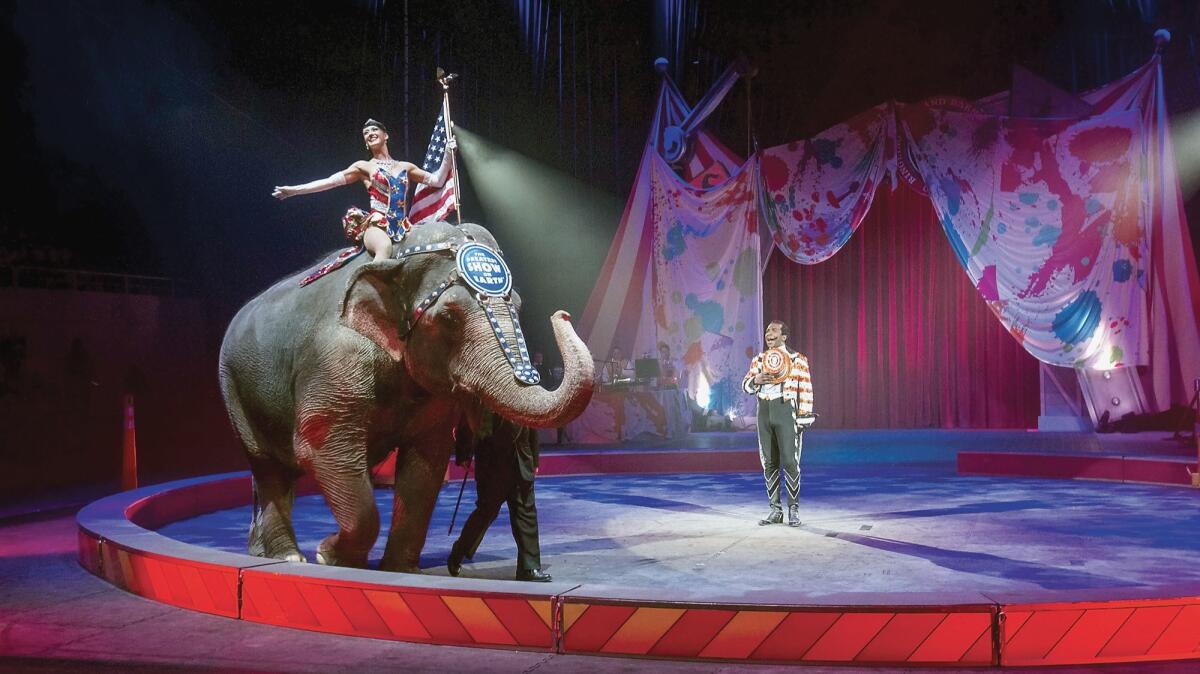Op-Ed: The demise of Ringling Bros. is a victory for the animal rights movement

- Share via
On Sunday, May 21, Ringling Bros. and Barnum & Bailey Circus will hold its final “greatest show on earth,” at the Nassau Coliseum on Long Island. For the last time, Ringling’s lions, tigers, camels and other captive animals will enter the ring and be forced to perform demeaning and unnatural tricks. It’s a momentous occasion that took the animal rights movement more than three decades to achieve.
I personally led some of the earliest rallies outside Ringling Bros. shows, back in the late 1980s. As the outcry from activists and advocacy groups grew, Ringling willfully ignored it. Instead of switching exclusively to human performers — who perform by choice rather than force — the 146-year-old institution continued to bully animals. This was its downfall.
The reason is simple: When it comes to animal rights, the tide of public opinion has turned. A 2015 Gallup poll found that a majority of Americans — 62% — believe that animals deserve protection, and 32% believe animals should have the same rights as people. In recent years, many businesses have been forced to change their practices. SeaWorld announced it would end its orca breeding program last March, and the state of California outlawed such programs a few months later. Several years ago, the Los Angeles City Council voted unanimously to ban the use of bullhooks on elephants, and the city of West Hollywood banned the sale of fur products. Many pet stores have stopped selling dogs from puppy mills.
Life for these animals is one of isolation, boredom and trauma.
But while the end of Ringling is a victory for every activist who wrote a letter, signed a petition or protested outside the circus doors, the fight to free animals from cruelty, including in the entertainment industry, is far from over. Other circuses continue to exploit animals for profit, as do zoos, aquariums and rodeos.
For instance, in 2002, an investigator for my organization, Last Chance for Animals, captured footage of elephant training at the Carson & Barnes Circus in Oklahoma. The video showed violent training methods in which elephants were abused with bullhooks, electric prods and blowtorches. At one point, a trainer yelled, “Make ’em scream!” The footage shook the circus industry to its core. Yet the Carson & Barnes Circus still features animal performers.
The simple truth is that animals should not be used for human amusement. The process often is unnatural and cruel from start to finish. Many are taken from the wild as babies and watch as their parents are slaughtered. Others are born in breeding facilities and never know freedom. Life for these animals is one of isolation, boredom and trauma — this is why they so often exhibit abnormal behaviors, such as pulling out their own fur, incessant swaying and bar biting.
As we have seen with the demise of Ringling, the power of sustained activism is strong, but legislation could help hasten and strengthen this hard-won progress. In March, federal legislation was introduced into the House to ban the use of wild and exotic animals in traveling circuses and exhibitions, the Traveling Exotic Animal and Public Safety Protection Act. We urge Congress to pass it. In April, the Los Angeles City Council voted unanimously to draft a ban on the use of animals for circuses and other live shows, including private parties. We urge the council to write a final version of the bill and enact it.
It took more than three decades for the animal rights movement to put an end to the cruelty Ringling Bros. and Barnum & Bailey Circus inflicted on animals. It shouldn’t take another three decades to eliminate similar animal mistreatment elsewhere.
Chris DeRose is president and founder of Last Chance for Animals (@LC4A), an international nonprofit organization dedicated to eliminating animal exploitation.
Follow the Opinion section on Twitter @latimesopinion or Facebook
More to Read
A cure for the common opinion
Get thought-provoking perspectives with our weekly newsletter.
You may occasionally receive promotional content from the Los Angeles Times.










